

Cashmere - The super-soft wool de luxe
Cashmere: the wool of the cashmere goat is indisputably considered a fashionable luxury item. Sweaters, scarves and hats are among the most popular good made from this exquisite fiber. The wool's versatility constantly opens the doors to new fields of application and product innovations. Recently this miracle fiber even made its way into the shoe industry. We have gathered the most important facts about cashmere and will show you how cashmere is and can be used.
WHERE DOES THE NAME CASHMERE COME FROM?
The rare wool comes from the cashmere goat. The animal, in turn, is named after the region Kashmir in the Himalayas, where the goat species was originally native. While Kashmir is no longer part of the largest producers of cashmere wool, the region remains an important hub.
WHERE DOES CASHMERE WOOL COME FROM?
Today, China and Mongolia are among the largest producers of cashmere wool, although countries such as Iran, Afghanistan, Pakistan, India and Nepal also have a long tradition of breeding the goats and harvesting their wool. There are about 20 different breeding forms of this goat species. Among the most important categorizations are probably color strokes: the goats can be found in white, gray, brown and black.
HOW IS CASHMERE WOOL EXTRACTED?
Cashmere wool comes from the goat’s undercoat, which is also called duvet. The amount of wool that can be harvested from one goat varies substantially. After a particularly cold winter the yield tends to be higher than after a mild one. Generally, one goat produces about 150 to 200 grams of the coveted luxury wool per year. To make a conventional cashmere sweater, it takes roughly the annual yield of about 2 to 5 animals.
Oftentimes, the rare goats are not sheared. Instead, the precious wool can be combed out with a special comb. This process is carried out during the animals' spring coat change. After combing or shearing the goats, the extracted wool is sorted by hand and subsequently washed. An important step, which is crucial for further processing, is the so-called boning. This describes the process of sorting the different hair fibers. Combing and shearing the goat not only extracts the filigree fibers of the undercoat but also the coarse hairs of the top coat. Only the pure undercoat hairs meets the quality requirements of further cashmere processing. Thus, the coarse hairs are sorted out.
WHY IS CASHMERE WOOL SO EXPENSIVE?
Cashmere is indisputably associated with luxury. This is mostly attributed to the scarcity of the wool. Not only is the number of cashmere goats limited but the annualy yield per animal is also quite scarce. Cashmere wool only accounts for less than 0.05% of the world's fiber consumption - only a fraction of the total world market. However, it is not only the special nature of the wool and its rarity that makes cashmere so precious. The process of extracting the wool, as descibed above, is also very complex and tedious.
WHAT CAN BE MADE FROM CASHMERE?
When you think of cashmere products, cashmere scarves and sweaters probably come to mind first. But fact is that cashmere wool can be made into a wide variety of garments. Its special thermal insulation makes the textiles especially attractive for colder seasons. But even in summer, cashmere shines with its temperature regulating properties. In addition to cashmere jackets, sweaters, scarves & Co. cashmere is now also used to make shoes.
WHAT MAKES CASHMERE WOOL SO SPECIAL FOR SHOE PRODUCTION?
1. Exceptionally soft and light
The ultra-fine cashmere fibers are even softer than merino wool. Especially as footwear, cashmere pampers your feet and allows for an extra comfortable sensation when worn barefoot.
2. Temperature and moisture regulating
Similar to merino wool, cashmere provides comfortable temperature control and moisture regulation. The wool provides excellent warmth while remaining breathable. When perspiration occurs, the wool wicks moisture away from the body immediately. Cashmere shoes, thus, assist in maintaining a comfortable foot climate.
3. Naturally dirt and odor repellent
Cashmere is a noble fiber and therefore needs gentle treatment once it gets dirty. However, since wool is naturally dirt and odor repellent, it is only after repeated wear (if at all) that the clothes need to be washed. Most of the time it is enough to let cashmere attire air out to get rid of unpleasant odors. This in turn makes cashmere an easy-going textile. When airing out is not enough a gentle washing cycle should do the trick. Just make sure you don't wash your cashmere fabrics above 30 °C.
4. Tear resistant yet flexible
Although cashmere is a very soft fiber, it is quite robust. Processed into a textile, cashmere is very resistant and durable. Due to its natural flexibility, the material still remains skin-flatteringly comfortable. Therefore, it is perfect for shoe production!
It is precisely because of these great properties and more that we have designed a shoe made from this miracle fiber.
WE INTRODUCE:
THE SUPER SOFT CASHMERE SNEAKER BY GIESSWEIN

With the release of the Giesswein Cashmere Sneaker made from a fine cashmere-merino blend, luxury feeling is combined with the tried and tested GIESSWEIN comfort. The soft properties of cashmere wool make every step feel like walking on clouds. The special thermoregulatory properties ensure optimal wearing comfort and temperature control adapted to the body. This ensures that you can comfortably wear cashmere even in summer. This exquisite sneaker is also equipped with an ultra-light premium sole, which promises ideal support without weighing down the wearer. In addition, the special anti-blister heels ensure that you can use the sneakers barefoot - which is especially pleasant on hot days. The stylish micro-fiber tags make it easy to put them on. The extra satin laces for women provide an extra luxurious finish.

GIESSWEIN's Cashmere sneaker combines luxury with comfort. For both chic and laid-back occasions, this sneaker is an eye-catcher. For women, this elegant luxury sneaker is best combined with a poncho, sweater or cardigan. For men, the sneaker perfectly tops off an outfit with a merino wool sweater or a chic woolen jacket.
FAIR EVERY STEP OF THE WAY
Just like with our merino wool, we make sure that all processes are ethically justifiable and fair. The dignified and fair treatment of cooperation partners and animals is incredibly important to us. Whether with merino sheep or cashmere goats - we guarantee species-appropriate husbandry and respectful treatment of all animals involved. Do you want to know more about our sustainability principles? Have a look at our Green Strategy, where we compiled our goals for a greener future.
Experience the sustainable luxury feeling of the Cashmere Sneaker. Your feet will thank us!























